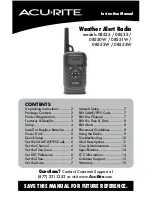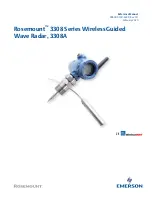
Safety and General Information
Important Information on Safe and Efficient Operation Read
This Information Before Using Your Radio.
Transmit and Receive Procedure
Your two-way radio contains a transmitter and a receiver. To control your exposure and ensure compliance with the
general population/uncontrolled environment exposure limits, always adhere to the following procedure:
Transmit no more than 50% of the time.
To transmit (talk), press the Push to Talk (PTT) button.
To receive calls, release the PTT button.
Transmitting 50% of the time, or less, is important because the radio generates measurable RF energy exposure only
when transmitting (in terms of measuring standards compliance).
To assure optimal radio performance and make sure human exposure to radio frequency electromagnetic energy is within
the guidelines set forth in the above standards, always adhere to the following procedures.
Portable Radio Operation and EME Exposure
Antenna Care
Use only the supplied or an approved replacement antenna.
Unauthorized antennas, modifications, or
attachments could damage the radio and may violate FCC regulations.
DO NOT hold the antenna when the radio is “IN USE.”
Holding the antenna affects the effective
range.
Two-way Radio Operation
When using your radio as a traditional two-way radio,
hold the radio in a vertical position with the microphone 1 to 2
inches (2.5 to 5 cm) away from the lips.
Body-worn Operation
To maintain compliance with FCC/Health Canada RF exposure guidelines, if you wear a radio on your body when
transmitting, always place the radio in a supplied or approved clip, holder, holster, case, or body harness for this product.
Use of non-approved accessories may exceed FCC/Health Canada RF exposure guide lines.
If you do not use one of the supplied or approved body worn accessories, and are not using the radio held in the normal
use position,
ensure the radio and its antenna are at least 1 inch (2.5 cm) from your body when transmitting.
Electromagnetic Interference/Compatibility
Note: Nearly every electronic device is susceptible to electromagnetic interference(EMI) if inadequately shielded,
designed or otherwise configured for electromagnetic compatibility.
Facilities
To avoid electromagnetic interference and/or compatibility conflicts, turn off your radio in any facility where posted
notices instruct you to do so. Hospitals or health care facilities may be using equipment that is sensitive to external RF
energy.
Aircraft
When instructed to do so, turn off your radio when on board an aircraft. Any use of a radio must be in accordance with
applicable regulations per airline crew instructions.
Medical Devices - Pacemakers
The Advanced Medical Technology Association recommends that a minimum separation of 6 inches (15 cm) be
maintained between a handheld wireless radio and a pacemaker. These recommendations are consistent with the
independent research by, and recommendations of the U.S. Food and Drug Administration.
Persons with pacemakers should:
ALWAYS keep the radio more than 6 inches (15 cm) from their pacemaker when the radio is turned ON.
Not carry the radio in the breast pocket.
Use the ear opposite the pacemaker to minimize the potential for interference.
Turn the radio OFF immediately if you have any reason to suspect that interference is taking place.
Medical Devices - Hearing Aids
Some digital wireless radios may interfere with some hearing aids. In the event of such interference, you may want to
consult your hearing aid manufacturer to discuss alternatives.



























